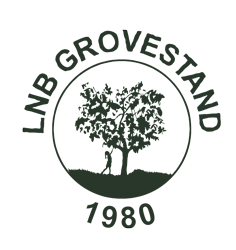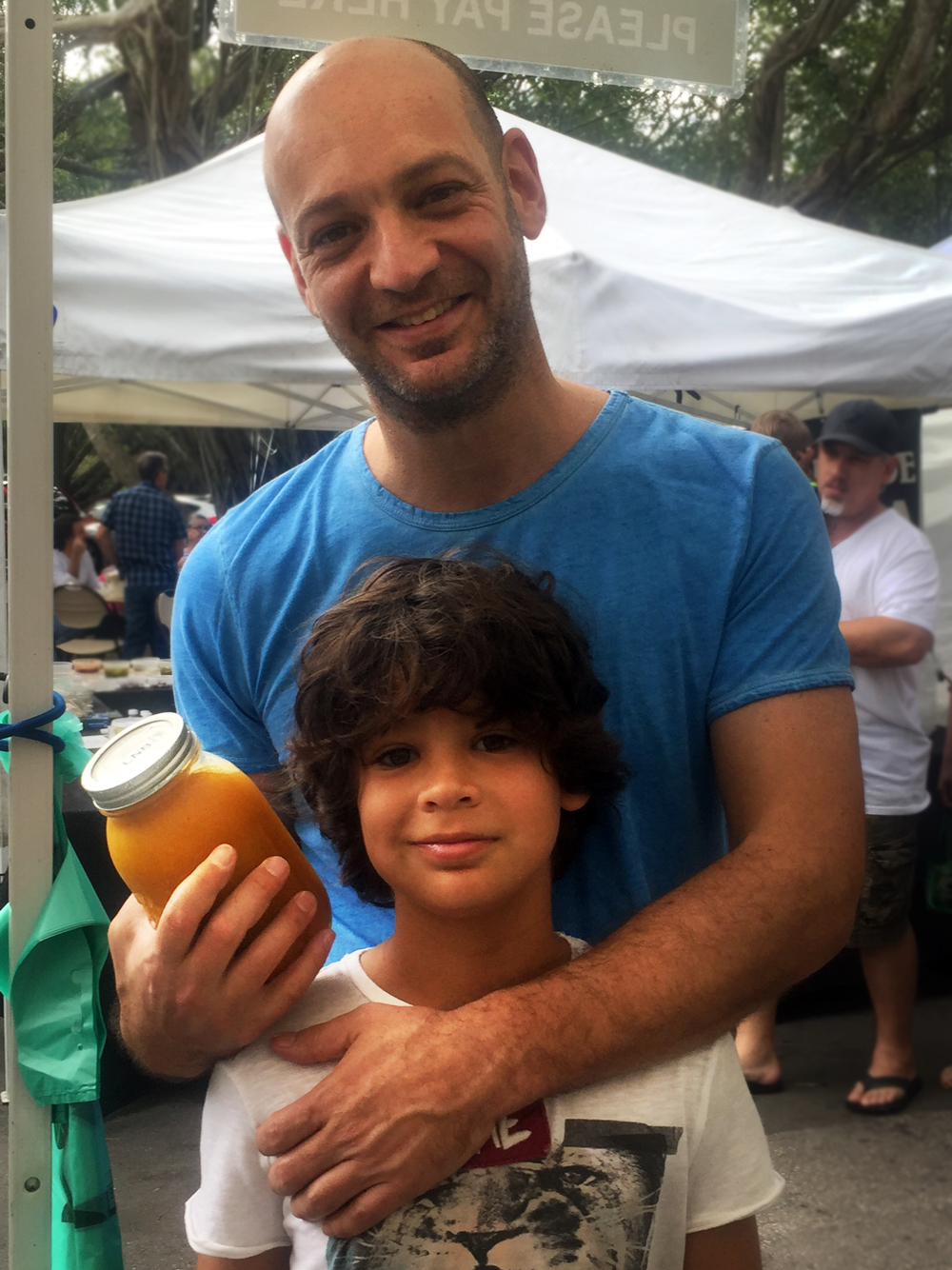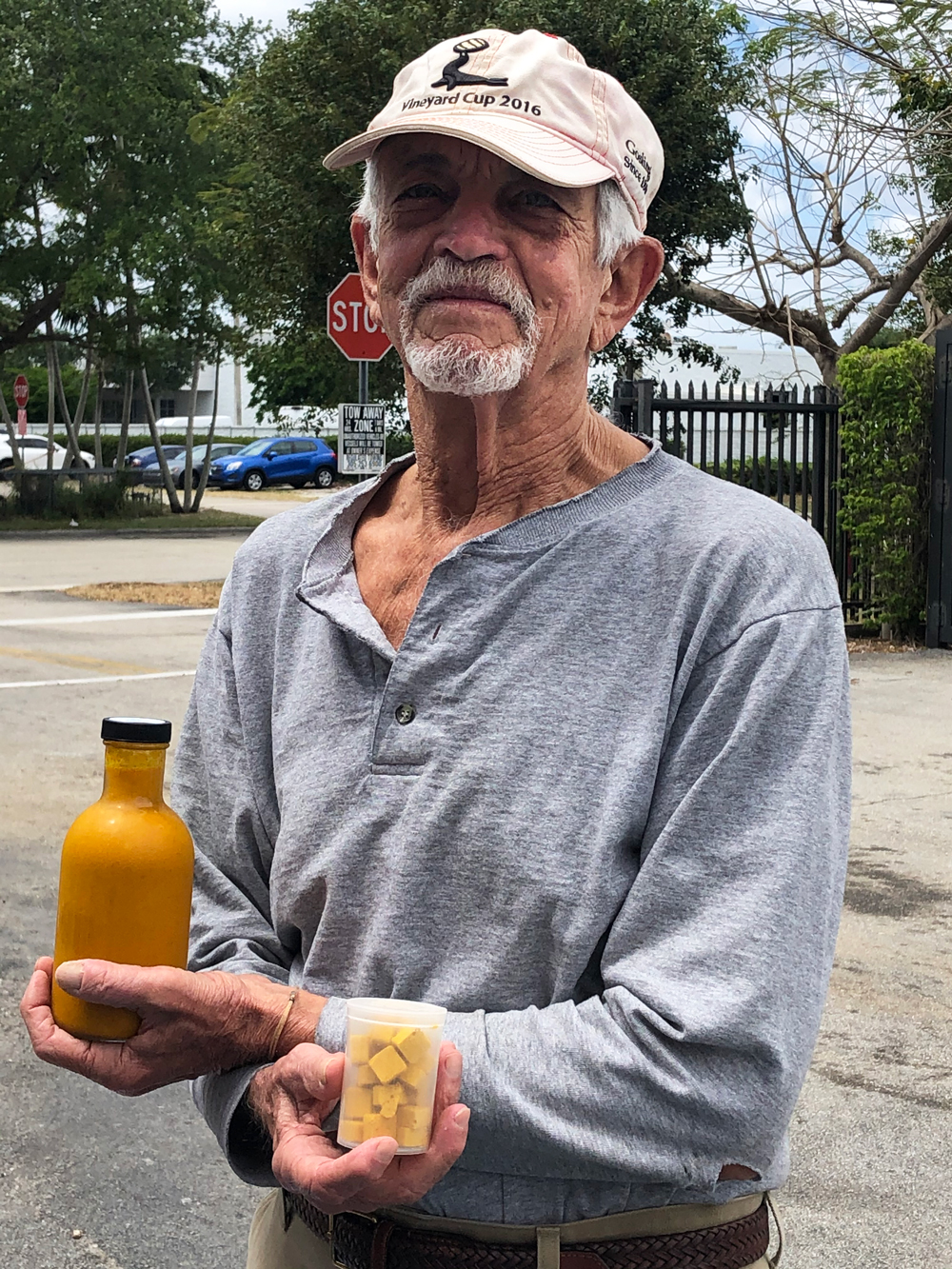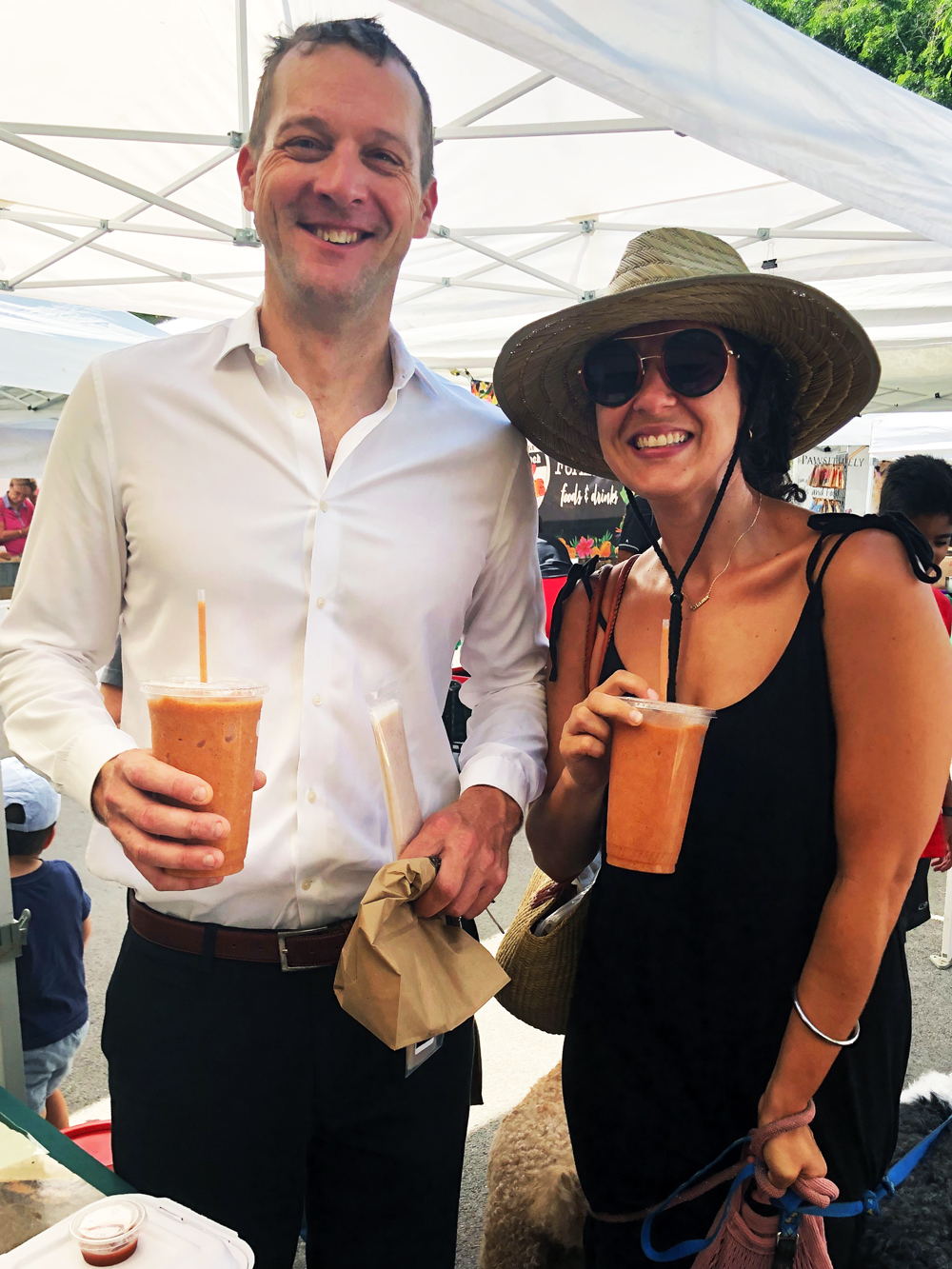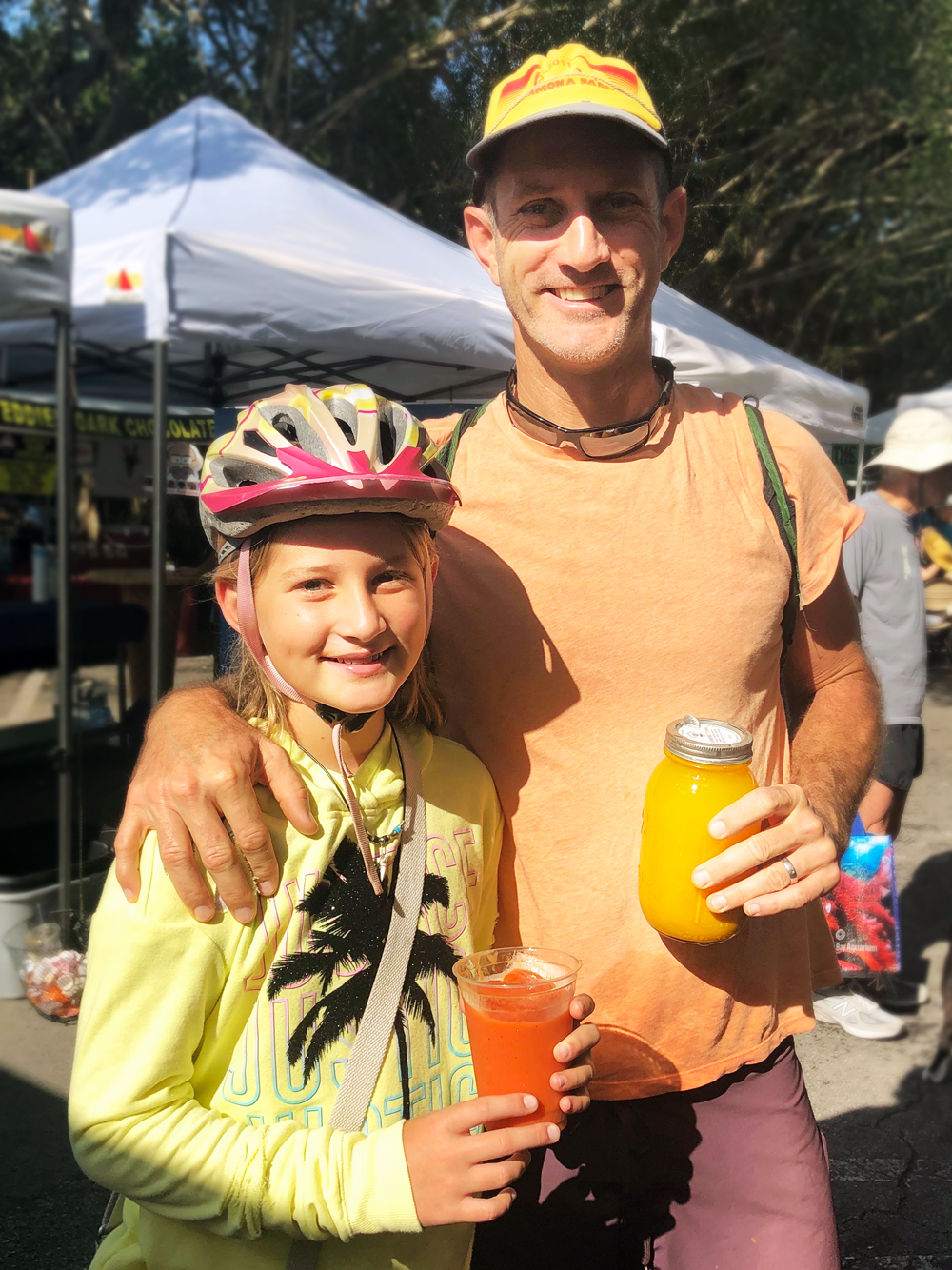
Thaddeus
Name:
Thaddeus Foote
What part of town do you live in?
Palmetto Bay
How long have you lived in this area?
I’ve lived in Palmetto Bay for two years. I grew up in Miami, left for a long time, and then I’ve been back for 12 years. First, in South Miami, then Pinecrest, and now Palmetto Bay. We keep moving south.
Would you share a little about your family?
I was born in Missouri, St Louis, on the coast of the Mississippi and Missouri River where my dad grew up. My Dad’s family is from Wisconsin and mom from Arkansas. On my eighth birthday, June 19th, 1981, we packed up the old Ford van and drove to Miami. My Dad was at Washington University in Saint Louis and he was hired to be president of the University of Miami. So, in the fall of 1981, we started our new chapter down here.
I went to school in the Grove. I left for a bunch of years but had it in the back of my mind to return to Miami someday. It’s a magical and sometimes kooky, screwy, and weird place, but unique and beautiful in more ways. 11 years later, after many adventures, I came back. Now, I’m married with two daughters.
Did you meet your wife on your adventures?
I married my middle school sweetheart, Carrie. We met at Ransom Everglades. The only way my insecure seventh grade self could express my appreciation for her was to throw Banyan berries at her. It worked.
Would you tell us a little bit about what you do now?
I’m a water guy. And, growing up in Miami, I love being outdoors. I enjoyed sailing, surfing, diving, fishing, and messing around the Bay. Eventually, I went to graduate school in New Hampshire. I knew I wanted to teach and share my passion for the outdoors and I studied environmental education.
As a student, I was never my best in the classroom. I was always a better student in nontraditional spaces. I was always very passionate and curious about learning, but the traditional schooling environment never inspired me. Fast forward many years, I’m still in education but mostly in my own way. As my journey continues, it’s interesting for me to look back and see those parallels.
Where and how do you teach?
Down here in Miami, I worked at Shake-a-Leg in their education department getting students, mostly with various disabilities and challenges, out on the water. I worked at Fairchild Garden for seven years in their education department. The Fairchild Challenge is a wonderful multidisciplinary program that works with 250+ schools in Miami Dade. I taught environmental science at Brown Mackie College (which is now gone). And most recently, I went back into the classroom to teach science at Gulliver.
Are you the type of teacher you wanted as a kid?
As of two days ago, I’m no longer employed with Gulliver. This may help answer that and make a very long story short – my children and I are going to home-school (for lack of a better term) next year. And, included in that will be some ‘world-schooling’. The structure of traditional education works wonderfully for some students and it doesn’t work well for others. We’re at the point where the education system, public and private, are slow to respond to modern day. There are so many different industries that have been shaken up, from ride sharing with Lyft and Uber, or Airbnb or micro brews or farmer’s markets. What you all are doing is localized and customized solutions that work better for people. It’s not a one size fits all. I think education is in a process of reinventing itself. I want to be part of that change. And in retrospect, I have been over the past 20 years getting out of the classroom and looking to work with students in different ways.
Will you work with just your kids, or do you want to teach a greater audience?
Absolutely. I’m hesitant to use the term ‘homeschooling’ because that usually assumes home and school. Sitting around the kitchen table talking about math is not at all what I envision. What I envision is tapping into the opportunities in the programs and projects that Miami is already doing. Whether it’s volunteering Downtown with a social organization or collecting data for a grad student in Biscayne Bay. Or, taking photography classes in Wynwood. Whatever that might become…gathering other families who are like minded, curious, and interested in letting students be part of the issue. I think that adults underestimate students in their abilities.
What lessons did you learn from your dad that apply to this vision?
Endless lessons and I’m still learning them. 50 years ago, before I was born, he was in Saint Louis working at Washington University. There was a blighted neighborhood called the Central West End that didn’t have a school. He had this vision that if they could start a community school, where local people would want to go, and families would want to be, their families would bring business and opportunity, and the neighborhood would blossom. I was just in St Louis and it’s happening. It’s a wonderful community school. Now, it’s reminiscent of Coconut Grove with restaurants and people walking around.
It’s one thing to have the idea, but then how do you share this with your community and how do you make your community better. My dad was all about community; he was blessed with many gifts and he shared them. So, I humbly use that as a lesson.
I watched a short movie about you being the first to paddle board from Bimini to Miami. It started with your wild idea and you made it a reality. You certainly take after your father. What advice might you give others with ideas who want to bring them to life?
Thank you. That was a great project and one of my crusades. I’d say, talk about it and share the idea. I think one of the primary issues when people are facing a challenge, whether it’s a potentially positive challenge – like paddling across the Florida Strait, or something difficult – like a home situation or substance abuse – whatever it might be, you’re not alone and there are other people who have similar experiences or desires and thoughts. If somebody is considering a challenge, no matter what it might be, talk about it and find people who share the enthusiasm and with that, by definition, it becomes bigger than an individual. To me that is spirituality and in that comes strength and the momentum to make things happen. It’s beautiful.
How often do you come to the Pinecrest market?
I go probably every other week. I would love to go more but logistics make it a challenge.
What’s your ritual like?
We go half just to just see friends and soak up the vibe and half to get some of our favorite things, which is smoothies from you guys, maybe some turmeric and then get some treats from Zak and then veggies from Bee Heaven from Margie. We walk up and down the aisle a few times and inevitably run into a bunch of friends and just catch up. I love the community atmosphere of it. I used to play music there with Zak.
What are your favorite smoothies from our stand?
I recently started doing the Rainbow, which I appreciate. I liked the Sapodelicious and Dragon Passion in the past. My daughter came up with a name for those two SapoDragonDelicious. And of course, you can’t forget the Kale one.
What do you think our market is missing?
I would love to play some more music. We can gather some likeminded friends and make it somewhat of a gathering around music.
Where do you all like to go out for food? What do you like to order?
I love Raw South, which I know was mentioned in one of your recent interviews. And, Black Point has a great dolphin and salad.
What about for a special occasion?
One of our locals is Alaine’s Osteria in Palmetto Bay. It’s usually packed, which is great for them, unfortunate for those waiting. But they do hand out wine on the house and make it as enjoyable as they can. I appreciate that. It’s good Italian.
Where is Miami’s best kept secret?
I think in the bottom of Biscayne Bay. I was just there yesterday and it’s so close, but so far away. And I think Miami has many spots like that, whether it’s in the mangroves or on the flats. I love paddle and kite boarding and getting out and finding that peace and tranquility. As you hold your breath and go underwater there is a peaceful spot. I think the more time we spend outdoors, the more connections we have and therefore the better stewards we will become as purchasing adults, as voting adults, and young people as well. It transcends borders, ideologies, education, religion, income, skin color. We are all in this together and the more time you spend outdoors, the more time we spend on the bottom of Biscayne Bay, it will benefit us all. I think a lot of this Movement is to preserve our spot in it and to take the best care that we can while we’re here.
What is a worthy splurge for you?
Oh Geez. Dark chocolate almonds.
On a bigger level, I just got myself a new guitar, a Martin 1991 oo-21. My dad had Martin Guitars. He had a 1959 D-18, which he bought brand new in college. His grandfather died and left him enough money to buy a little car and a Martin Guitar. When he first bought it, he removed the fret board and put on a classical fret board. So, it’s much wider because he had big fingers. Of course it destroyed the value, but it made it priceless in my mind because there’s nothing else like it. My new one reminds me of him.
What’s a good rainy-day activity?
I love playing in the rain for starters. If it were an indoor activity, play some music. I’m trying to get my girls into it. One of our favorite games is ‘FlaglerOpoly’ as in Henry Flagler & Monopoly.
Where’s the most romantic spot around?
First, I think that romance can be created anywhere with somebody you love. In my case, my wife. So, that could be on a bike, biking over the Chinese bridge or on a beach, boat, or in the kitchen. It’s more of a mindset than a place.
The next answer is that places can promote that feeling. There’s a spot close to where we live that overlooks Chicken Key, here in a Palmetto Bay. You can look southeast, across the bay and chicken key, with no lights. It’s just natural beauty, mangroves, and water. It certainly promotes that mindset.
What community events are coming up that are important to you?
The Mango Festival at Fairchild. It’s a great one because, being in the middle of July, most of the tourists are not here. It’s a rare glimpse into the mid-summer community that remains here in Miami and interested in tropical fruits. They do a beautiful job at promoting, showcasing, and educating people about mangoes and other tropical fruits as well. The farm down in Redland is open to the public. Go down there and learn about what they’re doing in connection with the garden on Old Cutler road.
Is there a question that you would like to ask us?
(T) What inspired this project?
(A+W) Adena’s grandmother, Lois Weisberg. She suggested that we introduce our customers to each other. She was notorious for connecting people. Malcolm Gladwell wrote about her as the connector in his book the Tipping Point. The format of the newsletter is based on an interview Walt gave in NYC many years ago. It’s grown from an email exchange into a phone interview, once a week, where we get to ask more questions and learn more about members of our community. Lolo will be happy – many connections are made each week. And, it’s very fun to put together.
(T) That’s cool! I think, just by definition the farmer’s market is that, a place to come together, for locals and sharing. I think this concept takes that backbone of the services offered at a farmer’s market and takes it to the next level, which I think is beautiful. So anyway, thank you for including me on this. I appreciate it.
Is there anything else that you would like to add?
Listen to the children. They’re wiser than we think.
Related Posts
Leave a Reply Cancel reply
You must be logged in to post a comment.
